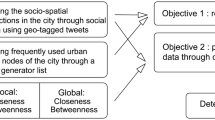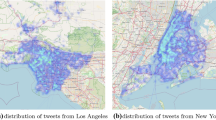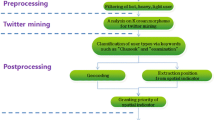Abstract
Today in our increasingly globalized world, the number of people travelling overseas is increasing. A system that helps overseas travelers by providing information related to unfamiliar places has been earnestly sought. This study develops such a system by exploiting user-generated data over a popular social network platform: Twitter. We propose the use of natural language processing (NLP) as a method of estimating location similarity between areas in different cities. Finally, location similarity is visualized on a map. Our experiment is conducted at two popular sightseeing cities: Bangkok, Thailand and Kyoto, Japan. Our evaluation using crowd-sourcing-based 1,000 questionnaires empirically demonstrated that the proposed method can find similar places in the two cities. This result demonstrated the fundamental feasibility of our approach.
Access this chapter
Tax calculation will be finalised at checkout
Purchases are for personal use only
Similar content being viewed by others
Notes
- 1.
- 2.
- 3.
- 4.
- 5.
- 6.
- 7.
- 8.
- 9.
- 10.
- 11.
- 12.
- 13.
References
Lynch, K.: The Image of the City. MIT Press, Cambridge (1960)
Nold, C.: Greenwich Emotion Map. http://www.emotionmap.net/ (2005)
Quercia, D., Schifanella, R., Aiello, L.M.: The shortest path to happiness: recommending beautiful, quiet, and happy routes in the city. In: Proceedings of Conference on Hypertext and Social Media (HyperText) (2014)
Quercia, D., Schifanella, R., Aiello, L.M., McLean, K.: Smelly maps: the digital life of urban smellscapes. In: Proceedings of the Ninth International AAAI Conference on Web and Social Media, pp. 327–336 (2015)
Aiello, L.M., Schifanella, R., Quercia, D., Aletta, F.: Chatty maps: constructing sound maps of urban areas from social media data. Roy. Soc. Open Sci. 3(3), 1–19 (2016)
Culotta, A.: Towards detecting influenza epidemics by analyzing Twitter messages. In: Proceedings of the First Workshop on Social Media Analytics, pp. 115–122 (2010)
Amador Diaz Lopez, J., Collignon-Delmar, S., Benoit, K., et al.: Predicting the Brexit vote by tracking and classifying public opinion using Twitter data. Stat. Polit. Policy 8(1), 85–104 (2017). Accessed 24 Aug 2018. https://doi.org/10.1515/spp-2017-0006
Gerber, M.S.: Predicting crime using Twitter and Kernel density estimation. Decis. Support Syst. 61, 115–125 (2014). https://doi.org/10.1016/j.dss.2014.02.003
Tumasjan, A., Sprenger, T.O., Sandner, P.G., Welpe, I.M.: Predicting elections with Twitter: what 140 characters reveal about political sentiment. In: International AAAI Conference on Weblogs and Social Media, Washington, DC (2010)
Hahmann, S., Purves, R., Burghardt, D.: Twitter location (sometimes) matters: exploring the relationship between georeferenced tweet content and nearby feature classes. J. Spat. Inf. Sci. Number 9, 1–36 (2014)
Preotiuc-Pietro, D., Cranshaw, J., Yano, T.: Exploring venue-based city-to-city similarity measures. In: Proceedings of the Second ACM SIGKDD International Workshop on Urban Computing, Article No. 16 (2013)
Kato, M.P., Hiroaki, O., Oyama, S., Tanaka, K.: Search as if you were in your home town: geographic search by regional context and dynamic feature-space selection. In: Proceedings of the 19th ACM International Conference on Information and Knowledge Management, pp. 1541–1544 (2010)
Seth, R., Covell, M., Ravichandran, D., Sivakumar, D., Baluja, S.: A tale of two (similar) cities: inferring city similarity through geo-spatial query log analysis. In: Proceedings of the International Conference on Knowledge Discovery and Information Retrieval (2011)
Acknowledgements
This work was partly supported by MIC SCOPE #171507010, AMED under Grant Number JP16fk0108119, and JSPS KAKENHI Grant Numbers JP16K16057 and JP16H01722.
Author information
Authors and Affiliations
Corresponding author
Editor information
Editors and Affiliations
Rights and permissions
Copyright information
© 2019 Springer Nature Switzerland AG
About this paper
Cite this paper
Takerngsaksiri, W., Wakamiya, S., Aramaki, E. (2019). City Link: Finding Similar Areas in Two Cities Using Twitter Data. In: Kawai, Y., Storandt, S., Sumiya, K. (eds) Web and Wireless Geographical Information Systems. W2GIS 2019. Lecture Notes in Computer Science(), vol 11474. Springer, Cham. https://doi.org/10.1007/978-3-030-17246-6_2
Download citation
DOI: https://doi.org/10.1007/978-3-030-17246-6_2
Published:
Publisher Name: Springer, Cham
Print ISBN: 978-3-030-17245-9
Online ISBN: 978-3-030-17246-6
eBook Packages: Computer ScienceComputer Science (R0)




